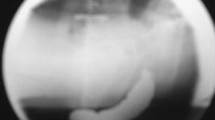Abstract
PURPOSE: The aim of this study was to investigate the influence of surgical technique on functional and manovolumetric results in patients treated with Marlex® mesh abdominal rectopexy. METHODS: The lateral ligaments were completely divided (the Wells procedure) in 16 patients and preserved (the Ripstein procedure) in 16 patients. Clinical and physiologic assessment were performed before and at 3, 6, and 12 months after operation. RESULTS: Improvement of continence was similar. Bowel regulation problems which were unchanged after the Ripstein procedure increased significantly after the Wells procedure (P<0.01). Rectal volume became reduced in the group who received the Wells procedure (225 mlvs. 115 ml, P<0.05 at one year), but remained unchanged after receiving the Ripstein procedure. The pressure thresholds required to elicit sensation of rectal filling and defecation urge were increased after the Wells procedure (15 cm of H2Ovs. 25 cm of H2O, P<0.05 and 25 cm of H2O vs. 45 cm of H2O, P<0.05, respectively). In the Ripstein group there was only a slight increase of the threshold for urge (P<0.05). CONCLUSION: The Wells procedure was followed by severe rectal dysfunction accompanied by increased constipation and evacuation problems. The Ripstein procedure, preserving the lateral ligaments, appears not to affect such symptoms adversely. On the other hand, improvement is not likely to occur.
Similar content being viewed by others
References
Wells C. New operation for rectal prolapse. J R Soc Med 1959;52:602–3.
Goligher JG. Surgery of the anus, rectum and colon. 4th ed. London: Baillière Tindall, 1985:224–58.
Ripstein CB. Surgical care of massive rectal prolapse. Dis Colon Rectum 1965;8:34–8.
Morgon CN, Porter NH, Klugman DJ. Ivalon (polyvinyl alcohol) sponge in the repair of complete rectal prolapse. Br J Surg 1972;59:841–6.
Gordon PH, Hoexter B. Complication of the Ripstein procedure. Dis Colon Rectum 1978;21:277–80.
Holmström B, Brodén G, Dolk A. Results of the Ripstein operation in the treatment of rectal prolapse and internal rectal procidentia. Dis Colon Rectum 1986;29:845–8.
Keighley MR, Fielding JW, Alexander-Williams J. Results of Marlex mesh abdominal rectopexy for rectal prolapse in 100 consecutive patients. Br J Surg 1983;70:229–32.
Delemarre JB, Goozen HG, Kruyt RH, Soebhag R, Maas Geesternaus A. The effect of posterior rectopexy on fecal continence. Dis Colon Rectum 1991;34:311–6.
McCue JL, Thomsen JP. Clinical and functional results of abdominal rectopexy for complete rectal prolapse. Br J Surg 1991;78:921–3.
Mann CV, Huffman C. Complete rectal prolapse: the anatomical and functional results of treatment by an extended abdominal rectopexy. Br J Surg 1988; 75:34–7.
Speakman CT, Madden MV, Nicholls RJ, Kamm MA. Lateral ligament division during rectopexy causes constipation but prevents recurrences: results of a prospective, randomized study. Br J Surg 1991; 78:1431–3.
Brodén G, Dolk A, Holmström B. Evacuation difficulties and other characteristics of rectal function associated with procidentia and the Ripstein operation. Dis Colon Rectum 1988;31:283–6.
Johansson C, Ihre T, Ahlbäck SO. Disturbance in the defecation mechanism with special reference to intussusception of the rectum (internal procidentia). Dis Colon Rectum 1985;28:920–4.
Åkervall S, Fasth S, Nordgren S, Öresland T, Hultén L. Manovolumetry—a new method for investigation of anorectal function. Gut 1988;29:614–23.
Sayfan J, Pinho M, Alexander-Williams J, Keighley MR. Sutured posterior abdominal rectopexy with sigmoidectomy compared with Marlex rectopexy for rectal prolapse. Br J Surg 1990;77:143–5.
Launer DP, Fazio VW, Weakley FL, Turnbull RJ Jr, Jagelman DG, Lavery IC. The Ripstein procedure: a 16-year experience. Dis Colon Rectum 1982;25: 41–5.
Penfold JC, Hawley PR. Experiences of Ivalon-sponge implant for complete rectal prolapse at St. Marks's Hospital. Br J Surg 1972;59:846–8.
Boutsis C, Ellis H. The Ivalon-sponge-wrap operations for rectal prolapse—an experience with 26 patients. Dis Colon Rectum 1974;17:21–7.
Duthie GS, Bartolo DC. Abdominal rectopexy for rectal prolapse: a comparison of techniques. Br J Surg 1992;79:107–13.
Ihre T, Seligson U. Intussusception of the rectuminternal procidentia: treatment and results in 90 patients. Dis Colon Rectum 1978;18:391–6.
Roe AM, Bartolo DC, Mortensen NJ,et al. Diagnosis and surgical treatment of intractable constipation. Br J Surg 1986;73:854–61.
Fasth S, Nordgren S, Hultén L. Evidence for a dual pelvic nerve influence on large bowel motility in the cat. J Physiol 1980;298:159–69.
Smith AN, Varma JS, Binnie WR, Papachrystomou M. Disordered colorectal motility in intractable constipation following hysterectomy. Br J Surg 1990; 77:1361–6.
Åkervall S, Fasth S, Nordgren S, Öresland T, Hultén L. Rectal reservoir and sensory function studied by graded isobaric distension in normal man. Gut 1989;30:496–502.
Dolk A, Brodén G, Holmström B, Johansson C, Nilsson BY. Slow transit of the colon associated with severe constipation after the Ripstein operation. Dis Colon Rectum 1990;33:786–90.
Frykman HM, Goldberg SM. The surgical treatment of rectal procidentia. Surg Gynecol Obstet 1969;129:1225–30.
Williams JG, Wong WD, Jensen L, Rothenberg DA, Goldberg SM. Incontinence and rectal prolapse: a prospective manometric study. Dis Colon Rectum 1991;34:209–16.
Author information
Authors and Affiliations
Additional information
Supported by grants from the Swedish Medical Research Council (17X-03117), University of Gothenburg, Gothenburg Medical Society, and Assar Gabrielsson's Fund.
About this article
Cite this article
Scaglia, M., Fasth, S., Hallgren, T. et al. Abdominal rectopexy for rectal prolapse. Dis Colon Rectum 37, 805–813 (1994). https://doi.org/10.1007/BF02050146
Issue Date:
DOI: https://doi.org/10.1007/BF02050146




